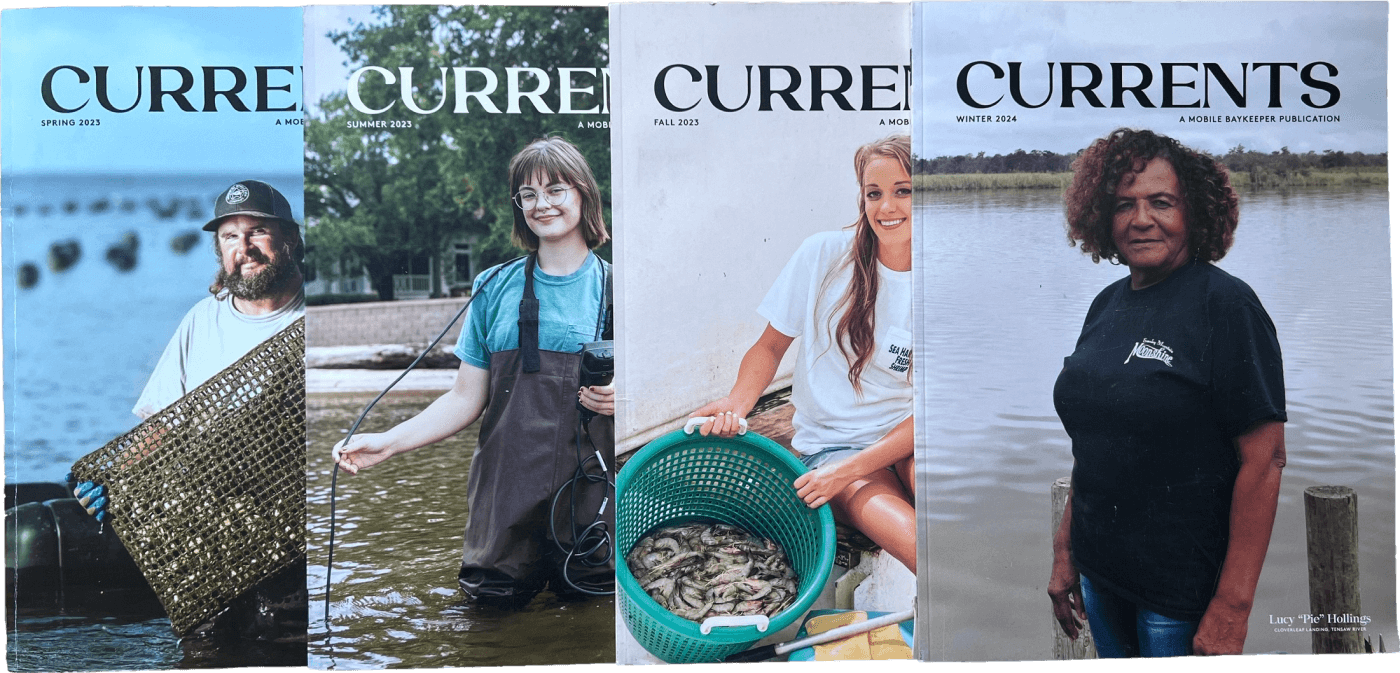
This article is from the summer 2024 edition of Mobile Baykeeper’s print quarterly, CURRENTS. The magazine is mailed to active members who have given more than $50 in the past year. To get on the magazine’s mailing list, donate here.
by William Strickland
A day in the life of a Mobile Baykeeper staff member comes with unexpected challenges. When we meet with industry leaders, there is often the sense they are suspicious of our motives. We try to go into every meeting with an open mind and assume each party has the best of intentions.
When Cade Kistler and I drove to Calvert in north Mobile County to visit Outokumpu, “America’s most technically advanced stainless-steel mill,” we weren’t sure what to expect. We had a meeting scheduled with the Outokumpu president and executive team to try to find ways to improve water quality in the communities we both serve. Tamara Weinert, the company’s president, had scheduled the meeting through a mutual friend because of her commitment to the environment.
As we entered the conference room, we were greeted warmly by Weinert and her team. They spoke directly and with transparency about plant operations. Their biggest concern involved the amount of nitrates that were entering our waterways from the Outokumpu facility.
Nitrates are a type of chemical known as nutrients, which are naturally occurring chemical compounds that exist in air, soil, and water. They are used by plants and tiny creatures like plankton to generate energy during photosynthesis. This energy is then trans- ferred to animals and humans when we eat them, making them crucial to the food chain. Two common nitrates are nitrogen and phosphorus. They act as building-block minerals to help living things function properly, but in excess amounts they can cause significant water quality problems.
Things like fertilizer runoff from farms and lawns, sewage overflows, and industrial stormwater runoff can load our waterways with excess nitrates like phosphorus and nitrogen. As with most things, balance is key. When too many nitrates are introduced into waterways, they create the perfect breeding ground for algae to take over. A large algae bloom blocks out sunlight, and what’s worse, it eats up most of the oxygen in the water, making it difficult for other species to survive. This can, in turn, kill off native seagrasses and even cause fish kills.
In the state of Alabama, there are no numeric nutrient criteria regulations. Although you must report the amount of nutrients you release into the water, you are not required to limit how much you discharge into nearby waterways. The absence of numeric nutrient criteria limits our regulatory ability to curb nutrient pollution effectively.
It makes sense for a company that is trying to stay competitive in the steel business to not be concerned about an input that is not regulated. However, the leadership at Outokumpu decided they needed to address this issue despite the lack of regulatory oversight. The company believes that the less they impact the waters, the longer they can sustain a functional business. It was decided that Wayne Denton, the company’s manager of environmental services, would research a system that would significantly reduce the the plant’s input of nitrates into the Tombigbee River.
Denton took us on a tour of the plant to show us how steel is made. He pointed out the company’s outfalls and other minor concerns they had with the facility.
Cade and I were impressed and grateful for their openness. We wondered if Outokumpu’s words would be followed by action. Not long afterward, we got news they’d be implementing a system that would reduce the company’s nitrate inputs tremendously. The system was relatively simple and inexpensive but would go a long way to improve water quality.
Some more time passed when Weinert reached out to give us an update on progress, and to try to find more ways to improve water quality by including other industry partners. It was a breath of fresh air, as I was dealing with a contentious issue with another large industrial business at the time. It’s much more fun to have lunch with someone who has water quality on their list of priorities.
In its first year of implementing the new system, the plant reduced its nitrate input by more than 40 percent. They were proud and excited to show us the results, adding that they planned to reduce their footprint even further. A reminder to the reader: this is all voluntary and not required by law.
Few people know that much of the pollution that impacts our waterways is legally permitted and happens around the clock. Industries create waste and generate runoff from their facilities. Those facilities must apply for permits that limit the amount of pollution they can discharge into our waters, but they are still allowed to discharge some. And nutrients are typically not on the list of limited pollutants in the state of Alabama.
Outokumpu is not the only company that takes extra measures to improve water quality, but they have been one of the best to work with. They are not perfect and still discharge pollutants, but they are taking steps to get better. Most of Baykeeper’s meetings are with companies that have no interest in doing more than the bare minimum. Even when we offer reasonable suggestions, the mindset is often, “if it is legal, we are doing it.” Trust is difficult to come by and even more difficult to maintain.
I asked Weinert why they decided to go above what is required. She said, “We do not take for granted that we work in a beautiful area of Mobile County. Our team strives every day to be the best mill it can be through our efforts to protect our waterways and keep them clean. We set high standards for ourselves because we know that the people who live and work near our mill are trusting us to do the right thing every day.”
If more companies took a long-term approach to sustainability, instead of only looking at short-term profits, it would hasten the day when no one has to question whether the fish are safe to eat, or the water is safe to swim in. Thankfully, Weinert and her crew are setting a great example by taking responsibility for the health of our waters.
Photo: Tamara Weinert at the Outokumpu plant, in Calvert, Alabama. Photo by Stevye Murray/courtesy Outokumpu
